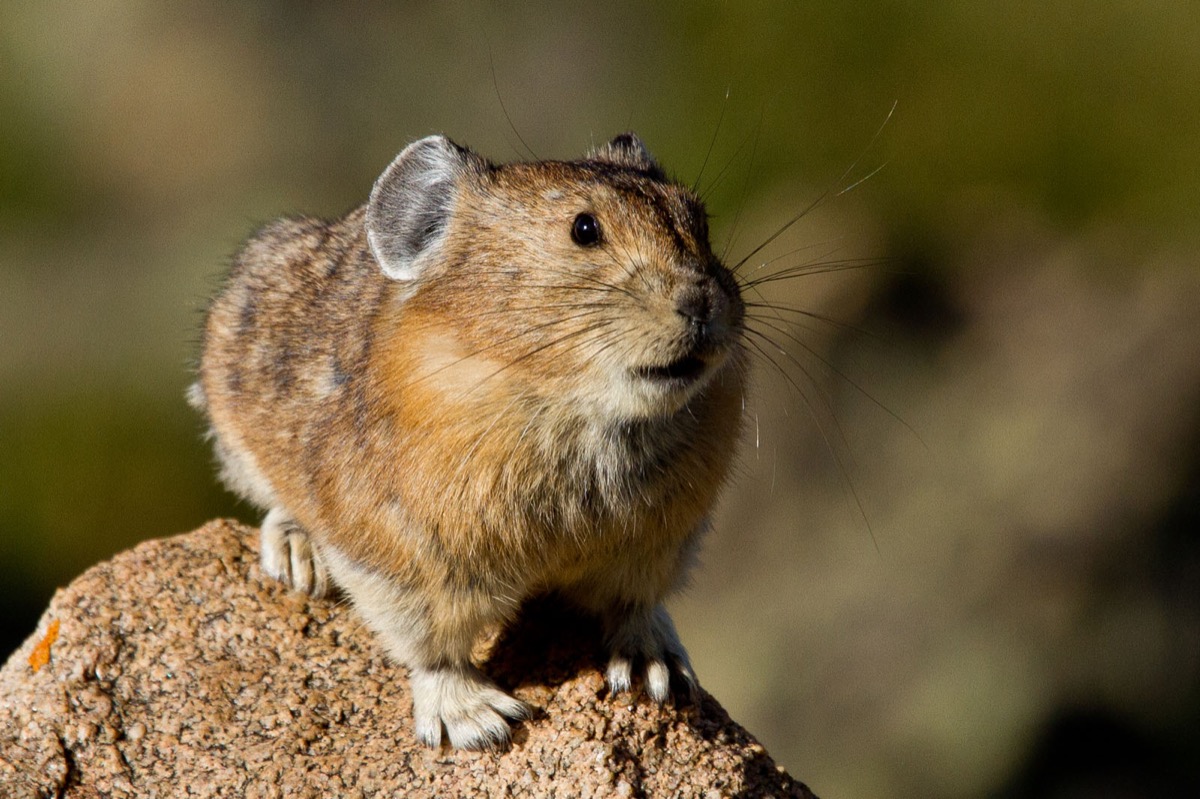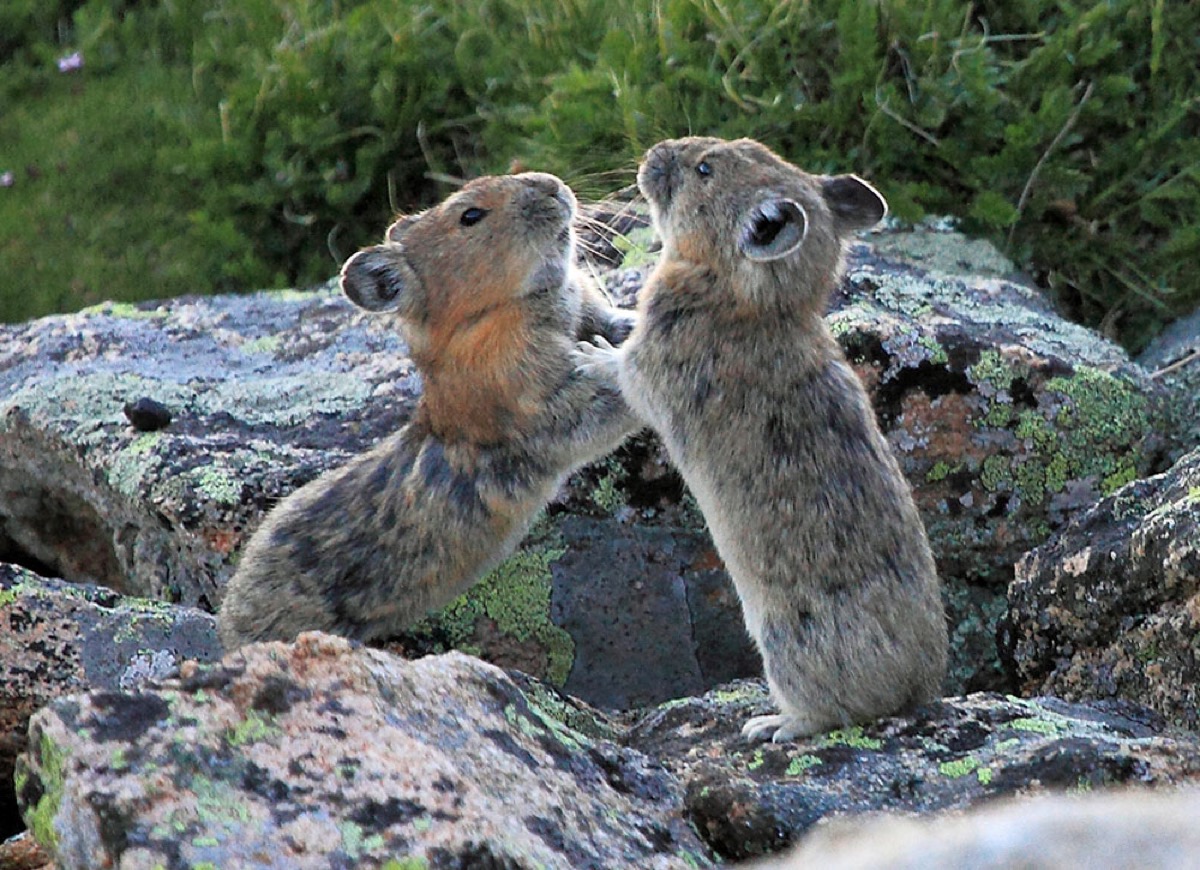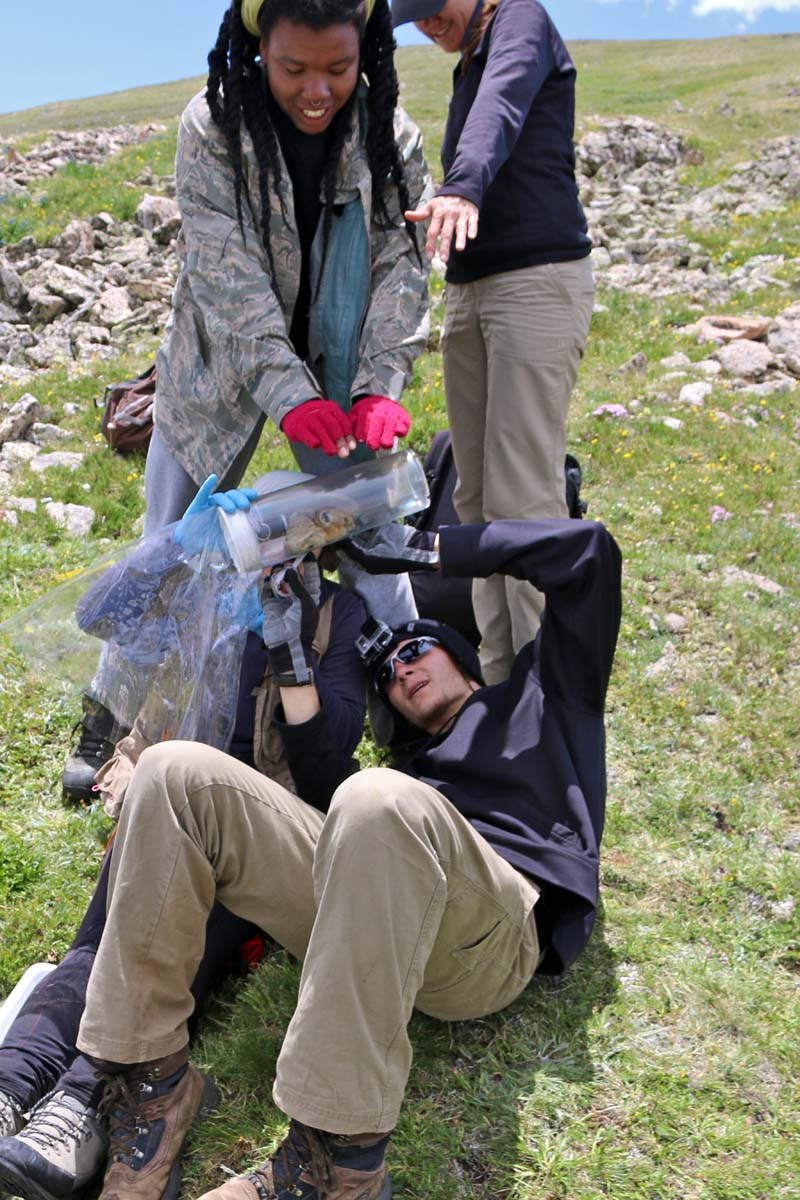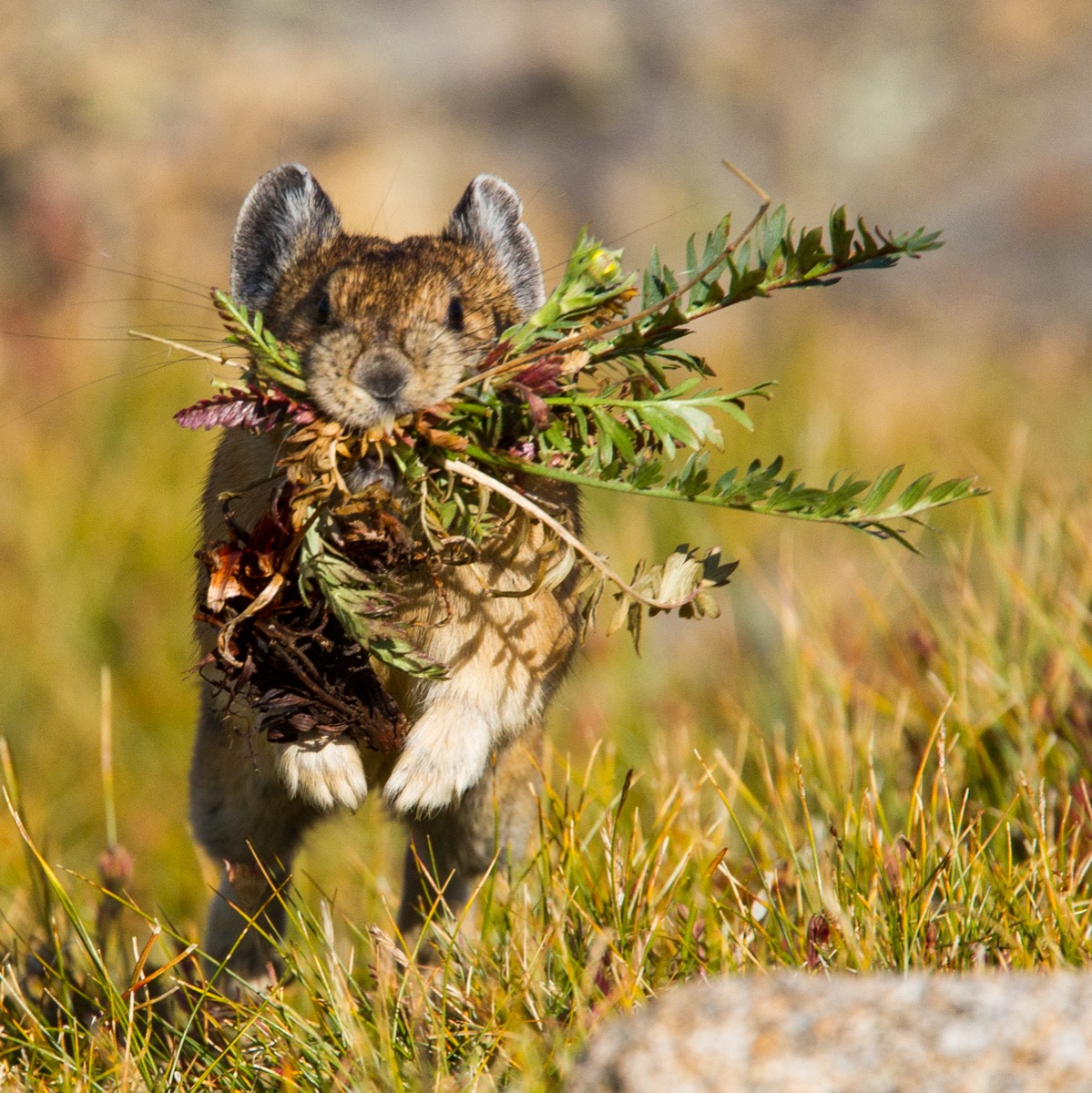How Climate Change Threatens Pikas
12:27 minutes
Credit: Jere Folgert
Pikas—those cute little animals that look like rodents but are actually more closely related to rabbits—used to roam high mountain habitats across the West. But global warming is pushing temperatures up in their high mountain habitats, and pikas are now confined to a few areas. And thanks to those warmer temperatures, which are threatening the pikas’ way of life, they may be in danger of disappearing—potentially as early as the end of the century.
In this segment, recorded as part of Science Friday’s live show at the Chautauqua Auditorium in Boulder, Colorado, Ira speaks with Chris Ray, a population biologist at the University of Colorado in Boulder. Ray is tagging and tracking the pikas to investigate how closely their fate is tied to climate change—and whether there’s a way to save them before it’s too late.




Chris Ray is a research associate in the Institute of Alpine and Arctic Research and the Department of Ecology and Evolutionary Biology at the University of Colorado, Boulder in Boulder, Colorado.
IRA FLATOW: This is Science Friday. I’m Ira Flatow, coming to you from the Chautauqua Auditorium in Boulder, Colorado.
[CHEERING]
If you’ve hiked around the high mountains here in Colorado and have scrambled between the boulders, you’ve probably spotted a fluffy little critter known as a pika. They’re pretty darn cute, but don’t confuse them with rodents. Oh, no. These tiny mountain dwellers are more closely related to rabbits. But as global warming pushes temperatures up in their high mountain habitats, the pika’s way of life is changing. And they may be in danger of disappearing, perhaps as early as the end of this century.
My next guest is tagging and tracking these animals to understand how we might save them. Chris Ray is a research associate at the Institute of Alpine and Arctic Research and the Department of Ecology and Evolutionary Biology at the University of Colorado right here in Boulder. Welcome, Dr. Ray.
[APPLAUSE]
Describe for our radio audience what a pika looks like.
CHRIS RAY: Hm. Well, it’s the only animal with truly Mickey Mouse ears. So it’s about as big as your fist. It looks like a baked potato with Mickey Mouse ears.
IRA FLATOW: I will never forget that now that you have described it that way. And we have a sound clip of these guys calling.
[PIKA CALLS]
So you’ve heard that often.
CHRIS RAY: Oh, yeah.
IRA FLATOW: So they’re not rodents. They look like rodents, but they’re not.
CHRIS RAY: No, they’re just related to rabbits and hares. And how often have you heard a rabbit or a hare? I mean, pikas are unique in that they have a lot of vocalizations. It’s really fun to listen to them.
IRA FLATOW: So give me the day in a life of a typical pika. What is that like?
CHRIS RAY: They get up just before dawn, and they start making their vocalizations, like you just heard. They start running around and defending their territory. And then they start collecting some forage to make a hay pile. Or maybe it’s a female, and she nurses their offspring somewhere far away from her hay pile. They’re very territorial, so they have to watch out and keep their offspring away from their hay pile.
IRA FLATOW: Hm. So the hay, is that their main staple diet?
CHRIS RAY: Yeah, they don’t hibernate. And yet they’re really small. And so they spend the summer collecting a hay pile and making sure that they have what they need inside their territory to survive the winter.
IRA FLATOW: Are they living among the rocks, or are they burrowing into the soil?
CHRIS RAY: They live in rocks, so rockslides, rock piles, lava beds. Anywhere where there’s fractured rock, they get down between the crevices. It’s really cool down there in the summertime. If you ever stick your hands down in the rocks, you’ll notice how much cooler it is– much more stable climate down underneath there.
IRA FLATOW: Now I understand that pikas once lived in mountain ranges all over the west. Is that right?
CHRIS RAY: That’s right. And they have been disappearing, especially in the center of the distribution in Nevada. We’ve been losing populations from some mountain ranges.
IRA FLATOW: And why is that? Why are they dying out?
CHRIS RAY: Well, that’s one reason that I still study them. We’re not 100% sure, but the projections are that with climate change, pikas will disappear– warming summers and perhaps a loss of snow in the wintertime. So pikas are adapted to be perfectly comfortable at about freezing, right where water freezes, that temperature. And if they have a snowpack, a snowpack even just ankle deep can keep the ground temperature right about freezing. And so pikas are comfortable all winter. But if you lose that snowpack, they can get really cold. It can get much below freezing, especially with wind chill. And so they might be actually freezing to death in colder winter conditions due to global warming, which is sort of ironic.
IRA FLATOW: So yeah, it is. You mean the snowpack will go away, and that’s sort of their blanket.
CHRIS RAY: Yep, that’s their wintertime blanket. And so if their hay piles aren’t big enough or good enough to survive a really cold winter with no snow on the ground, perhaps they don’t make it.
IRA FLATOW: Hm. Might they migrate to other places?
CHRIS RAY: So pikas only move right after they’re born. They’re born, and then they have to go off and find a territory. And when they find one, they stay there for life. So when we see pikas disappearing from a place, it’s not because they just got up and moved. It wasn’t the right temperature. It’s because they didn’t make it. They didn’t survive, or they didn’t reproduce there.
IRA FLATOW: I understand that you’re actually vaccinating pikas up there in the mountains. Tell us why.
CHRIS RAY: Well, if we’re not going to do a huge amount about climate change, we have to mitigate other possible threats to animals. And one of the possible threats is plague. So literally, bubonic pneumonic plague that humans can get, it came into North America about 100 years ago from Asia. And it swept east, and it ended up coming through the Rocky Mountains and was out here by about 1940. And it’s probably had huge impacts on the small mammal community. And it’s common in mountain areas, where pikas and marmots live in Asia. So we think that it might be common here, too, but no one’s studied it. So we’re giving the plague specific vaccine to pikas to see whether or not it increases their survival.
IRA FLATOW: So if I’m going up to look for these pikas in the places that you just mentioned, should I be fearful that I’m going to get the plague?
CHRIS RAY: No one has yet, and we haven’t seen an enormous difference in survival between the pikas that we’re vaccinating and the ones that we’re not. So it’s possible that soon we will show that plague is not circulating in these communities.
IRA FLATOW: By the way, the plague is easily curable, right?
CHRIS RAY: Yes, it’s just a bacterial disease. And so–
IRA FLATOW: There you go.
CHRIS RAY: As long as you get it early enough, go to the doctor if you think you have the flu and say, hey, I was near what could have been a small mammal flea. And maybe I have plague.
[LAUGHTER]
IRA FLATOW: And tell him you heard it on Science Friday, so they’ll believe you. Yes, over here.
AUDIENCE: What can I do to help pikas survive?
CHRIS RAY: Well, make some good choices regarding your carbon footprint.
[APPLAUSE]
IRA FLATOW: I told you the kids ask the best questions.
CHRIS RAY: It is.
IRA FLATOW: OK, right here.
AUDIENCE: So you said that the newlyborns will leave to find their own territory, correct?
CHRIS RAY: Yes.
AUDIENCE: So does that mean that if they were to come back to the territory, would the mother welcome them? Or would they shoo them off as in, you’re in our territory, get out, or they’d be like, oh, hello, you’re my child?
[LAUGHTER]
CHRIS RAY: Well, you’re–
IRA FLATOW: I was thinking the same thing myself.
CHRIS RAY: Your mom would definitely shoo you off. She would chew you out, chase you off, and try to bite your rump.
[LAUGHTER]
IRA FLATOW: I can’t touch that line. Can’t better that one. Yes. Thank you for that question. It was a great question. Yeah.
AUDIENCE: How big are their territories?
CHRIS RAY: About the size of this stage would be a pretty good size pika territory, so about the size of a tennis court.
IRA FLATOW: Really? That’s not very big, is it?
CHRIS RAY: No, no. They live in colonies kind of close to each other, but they don’t tolerate each other in each other’s territories. They have to be close enough, though, to communicate about predators that might be coming through. So they help each other out at a distance.
IRA FLATOW: And then they actually box each other sometimes?
CHRIS RAY: The males at least appear to box. I’ve certainly seen that a couple of times. It’s not really common, but this is a fantastic image of it here. That’s two pikas probably contesting the same territory. One of them wants it, and the other one wants it, too. And they’re boxing to figure out who’s going to get it.
IRA FLATOW: Are they boxing, contesting for females, also, for mating?
CHRIS RAY: No, the mating’s kind of sneaky. They just go behind a rock and do their thing. I’ve never seen it, sadly.
IRA FLATOW: Pretty sneaky. Ah yeah, go ahead.
AUDIENCE: Can you elaborate on what role the pikas play in the ecosystem exactly?
CHRIS RAY: Yeah, yeah. So they’re small, so everything eats them. That’s the one thing. They’re herbivores, and they do a bunch of collecting of hay– hay being grasses and flowers that they gather from the environment around their territory. And then they put it all underneath a rock, and that ends up creating soil and a seed bank in the rocky areas, which ends up eventually changing the rocky area to a grassy area. So they’re ecosystem engineers in that sense. So yeah, mainly as prey probably, especially important prey in the wintertime when other things are hibernating and pikas are still active.
IRA FLATOW: Would they be birds, raptors, sort of, things?
CHRIS RAY: Yeah, owls tend to have lots of pika bones in their pellets.
IRA FLATOW: Another fact you can go home with this afternoon. Yes.
AUDIENCE: So you mentioned that pikas never leave their territory once they establish it. But could a pika community adapt to relocation to protect them from declining snowpacks to insulate them from winter temperature extremes?
CHRIS RAY: Yeah, relocation is something that we’ve considered looking into. It’s difficult. You’ve never seen pikas in zoos, probably. They’re very difficult to handle and keep even in a laboratory situation. They’re thermally sensitive. They don’t like it. At 75 degrees, they can die in a couple of hours.
IRA FLATOW: Really?
CHRIS RAY: So at temperatures that we’re really comfortable at, yeah.
IRA FLATOW: We were talking about them being similar to rabbits. They don’t make good pets.
CHRIS RAY: No. They seem like they would when you see them in the wild because they’re so spunky. But they really need access to that cool microclimate underneath the rocks. And if they don’t have that, they’ll expire pretty soon. So relocating them is a difficult task. And relocating a whole population, that would be really tough.
IRA FLATOW: So between the combination of plague and climate change, how optimistic are you about the plight of the pikas?
CHRIS RAY: We think that they might disappear in this century, but they’re really good at finding these micro climates. And a pika is a small thing that can get down underneath the snow underneath the rocks. Other animals might be more sensitive to climate change than pikas because pikas are small and can find these places where the climate might not be changing so much. So I’m slightly optimistic. Also, pikas live in some very hot places. There are pikas on the edge of the Gobi Desert. They just don’t spend much time on the surface. So even if they do survive, they might become less visible to us and less interesting.
IRA FLATOW: We’d like to give our listeners citizen science projects. Is there one they could do with pikas? Is tracking– I’m just thinking out loud. Anything that they might help you with?
CHRIS RAY: Absolutely. Locally, we have the Front Range Pika Project, and that is something that involves people all around the Front Range through the Denver Zoo and Rocky Mountain Wild to go out to places, get trained, and survey for pikas in all these different habitats every year. And there are citizen science projects that share our protocol all throughout the west. So different states have their own citizen science pika projects. It’s actually a really fun thing for people to go out and do during the summer.
IRA FLATOW: All right. That’s about all the time we have. Thank you. This was really interesting.
CHRIS RAY: Thank you, Ira.
IRA FLATOW: Dr. Chris Ray, research associate at the Institute of Alpine and Arctic Research and the Department of Ecology and Evolutionary Biology, The University of Colorado, here in Boulder. And now would you please welcome back our musical guest, Zimbera.
[MUSIC PLAYING]
This is Science Friday from WNYC Studios.
Copyright © 2019 Science Friday Initiative. All rights reserved. Science Friday transcripts are produced on a tight deadline by 3Play Media. Fidelity to the original aired/published audio or video file might vary, and text might be updated or amended in the future. For the authoritative record of Science Friday’s programming, please visit the original aired/published recording. For terms of use and more information, visit our policies pages at http://www.sciencefriday.com/about/policies/
Christopher Intagliata was Science Friday’s senior producer. He once served as a prop in an optical illusion and speaks passable Ira Flatowese.